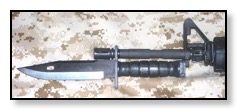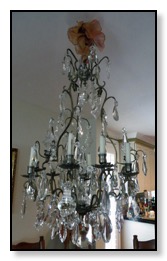measured highlight (bulbs) don’t romantically Fit
Here in Santa Barbara, I’m in awe of the speedy progress that Nazy has made on the settling-in front. She’s jammed stuff..
“Jammed, Dan?” Nazy says, interrupting my composition time.
“Put?”
“Decoratively placed is...”
“.. more accurate?” I asked. Rhetorically.
Nazy’s sorting, consolidating and deciding expertise was complemented by my talent with hand tools and lumber-yard negotiation:
“We need 5 shelves, Dan,” Nazy asserted. “They should be 31 inches long and 12 inches wide.”
“What’s that in centimeters?” I asked as I grabbed the tape-measure.
“Who cares and why are you re-measuring?”
“The golden rule of home improvement, my dear: measure twice, cut once.”
“If you measure twice, you’ll get two different answers.”
“Undoubtedly! However, in this case,I have confirmed your measurements. Well done.”
“The result would have been different if I had to confirm your measurements,” Nazy thought.
We drove to Home Depot and quickly confirmed that no standard shelves came in a 31” length. However, they agreed to cut five inches off the standard 36” shelves. I pulled five shelves off the 12” x 36” stack and carried them to an industrial-strength saw.
“Remember,” the saw-er reminded me, “no refunds after we’ve made the cut.”
“That’s why we measured twice,” I gloated. “It would have been nice if he warned us about that before he made the cut,” I thought.
Back home, I installed the brackets and positioned the shelf. The instant that I shut down the anti-gravity nullification field, the shelf plunged to the floor. “This shelf is too thin!” I exclaimed.
It turned out that the shelf (and the other four) that we had purchased were each 10” wide, not 12” wide.
“I’m so happy that you measured twice,” Nazy observed.
Equipped (this time) with a tape measure, I drove back to Home Depot. As I (now) expected, both 10” and 12” shelves were misplaced. I had another five shelves(12 inches wide) “Cut to Fit”. (Hopefully.)
Back home, I confidently strode to the closet. I lifted the top shelf into place and boldly disconnected the anti-gravity device.
“Disconnected the anti-gravity device?” Nazy asked. “Why do you keep saying that and what do you mean?”
“I let go.”
The shelf, which was wide enough this time, was now too short. It plunged to the floor. After a bit of finger-pointing (“You didn’t measure before he cut?”... “You said it was 31 inches!&rdquo![]() we discovered that the middle shelf was 31 inches long. The bottom shelf was 30.5 inches wide and the top shelf was 31.75 inches. I could get everything except the top shelf in place. (The top and bottom of the closet had different lengths.) I thought (briefly) about adjusting the entire house. But, in the end, forgoing Home Depot, I drove to a local hardware store.
we discovered that the middle shelf was 31 inches long. The bottom shelf was 30.5 inches wide and the top shelf was 31.75 inches. I could get everything except the top shelf in place. (The top and bottom of the closet had different lengths.) I thought (briefly) about adjusting the entire house. But, in the end, forgoing Home Depot, I drove to a local hardware store.
“Yes sir,” the clerk explained. “I can cut yet another shelf into ..”
“He did nott say ‘yet another’, Dan.” Nazy claimed.
“He thought it,” I replied.
“... you might also try these shelf brackets. They’re a little longer and you may get it to work. If that doesn’t work, you could buy some 3/16 inch dowel...”
“I’ll take both!” I said.
“We are out of 3/16” dowel. Can you come back on Monday?”
Last week’s edition of The Weekly Letter asked for reader feedback about the return address labels that I selected (all by myself). Very few people sent Nazy an email that endorsed my selection. (By ‘very few’, I mean ‘none’.) The issue has been rendered moot because Nazy ordered a set of replacement labels. We have concluded that the label displayed on the MacBook Pro’s vivid screen is not representative of the label printed on adhesive strips. (And, speaking of adhesive strips, both labels would probably look better if someone bled on them.)

Encouraged by my success with the shelves, I decided to tackle outstanding light bulb challenges.
I had experienced significant challenge during light-bulb hunting excursions in Zurich. (See Weekly Letter from 2003) Our home there featured an enormous variety of sizes, connector designs and shapes. We eventually discovered (after several years) that we could get everything at the AKZ store in the center of the city. At the end of our time in Zurich, i.e. once we had figured out where to find every bulb, we faced the additional difficulty of finding a light bulb that..
“.. radiates light!” I exclaimed. “I want a bulb that, eh, lights up when I flick the switch.”
“These are environmentally friendly.”
“So is a carrot, but I can’t read by the light of a carrot. Bio-luminescent fish generate more photons than these environmentally friendly ‘light’ bulbs. It’s like trying to read by the light of Alpha Centauri.”
Luckily, even here on the ‘Left Coast’ of America, the energy-saving light bulbs come on, at full wattage, immediately. They don’t gradually ramp to full wattage. (And, full wattage can be 100 Watts, not 6 Watts.) However, our European illumination hardware features non-standard bulbs. Consider the chandelier..
“These are automobile brake light bulbs,” Steve, the electrician claimed. “12 Volt - DC. You can’t use them in an American house,”
“They are 220V light bulbs,” I replied. “they will work - but dim. Do you know where we can find..”
“They’re bayonet mount..”

“... that sounds troubling,” I thought. “Do I need a background check?” I asked.
“... maybe you can find them on the internet.”
“Of course!” I replied. “You can find anything on the Internet.” (I was thinking about the wheelbarrow that unfolded into a shower curtain that I’d seen on ‘youneeditwehaveit.com’.

We’ve ordered the chandelier bulbs. (But we’re waiting for delivery before we claim victory.) We’ve been unable to locate 110V bulbs for Nazy’s floor lamp. The ‘fat’ base bulbs are too fat, the ‘thin’ base bulbs are too thin and the intermediate (e.g. ceiling fan size) bulbs are, eh, compromised and unusable. I found appropriately sized kitchen flood lights, but Nazy wanted ‘soft white’ instead of ‘daylight’. For the sake of veracity, I confess that I also bought some crystal clear bulbs when ‘plant friendly’ was requested, (and round, when pointed was prescribed). And I dropped the 31 inch long, five shelf stack on the bag containing the lamp bulbs. (And then feigned surprise when Nazy noted that ‘lie flat’ bulbs don’t work.)
Finally, as the photo shows, we have a low-electrical usage backup system for the dining room chandelier: candles. Moreover, the 220V bulbs that we brought from Switzerland do work.. dimly. In sum: our (romantic) existing solution generates enough light to see what we are eating - but not so much that we can tan while sipping wine.


